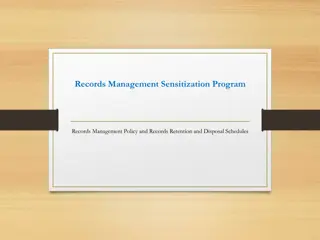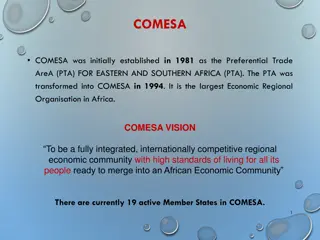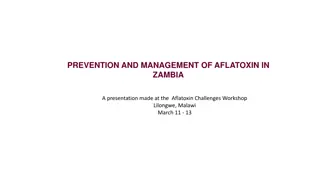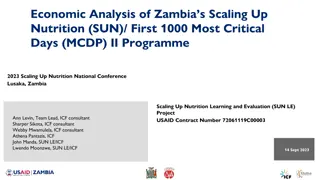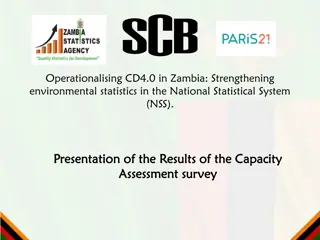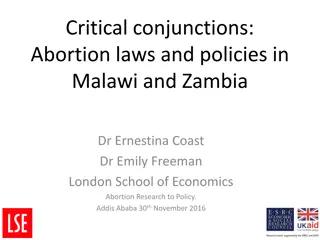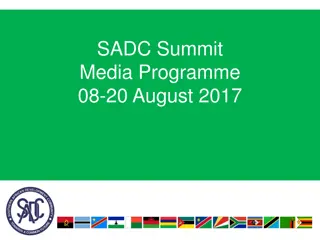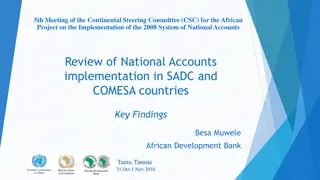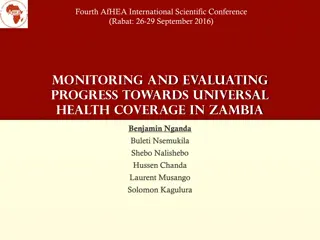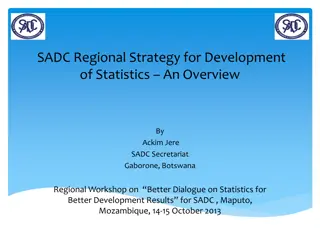Past Performance of Zambia in COMESA and SADC
Zambia's trade involvement in COMESA and SADC regions, including its export and import partners, trade overview within COMESA, and the impact of regional integration on the country's economy. The content discusses the successes, challenges, and historical background of regional integration in Africa, focusing on Zambia's participation in two major trade blocs. It also highlights the trade value trends and key import partners of Zambia from COMESA.
Download Presentation

Please find below an Image/Link to download the presentation.
The content on the website is provided AS IS for your information and personal use only. It may not be sold, licensed, or shared on other websites without obtaining consent from the author.If you encounter any issues during the download, it is possible that the publisher has removed the file from their server.
You are allowed to download the files provided on this website for personal or commercial use, subject to the condition that they are used lawfully. All files are the property of their respective owners.
The content on the website is provided AS IS for your information and personal use only. It may not be sold, licensed, or shared on other websites without obtaining consent from the author.
E N D
Presentation Transcript
Past Performance of Zambia in COMESA and SADC 1 / 23
Contents Introduction Zambia s Trade Overview COMESA SADC Successes Challenges Impact of Regional Integration 2 / 23
Introduction Regional integration carries long history in Africa Currently more economically inclined, with policy focus on: Value addition beneficiation of resources participation in regional and global value chains In Africa RTAs are championed by RECs, as Africa moves towards AEC Each REC has an RTA in form of an FTA or CU Regional integration has been identified as ideal for Attracting FDI Lowering cost of doing business Since 1970s many RTAs have emerged in Africa Web of overlapping RTA membership in Africa Zambia is a member of COMESA and SADC in Southern Africa Trade is concentrated in SADC and COMESA in Africa 3 / 23
Zambias Export Partners Regions vs. ROW COMESA SADC Tanzania, United Republic of 1% Malawi 1% Malawi 2% Kenya 1% Mozambique 1% Zimbabwe 4% Zimbabwe 4% Congo, Democratic Republic of the 8% Congo, Democratic Republic of the 8% South Africa 8% World 86% Rest of World 77% 4 / 23
Zambias Import Partners Regions vs. ROW COMESA SADC Mozambique 1% Zimbabwe 1% Tanzania, United Republic of 1% Zimbabwe 1% Namibia 1% Kenya 5% Mauritius 6% Mauritius 6% Congo, Democratic Republic of the 11% Congo, Democratic Republic of the 11% South Africa 31% Rest of World 77% Rest of World 48% 4 / 23
Trade Overview How Zambia Ranks Within COMESA 5 / 23
Trade Overview Zambia s Trade With COMESA 3 2.5 2 Trade Value in USD billions 1.5 1 0.5 0 2001 2002 2003 2004 2005 2006 2007 2008 Years 2009 2010 2011 2012 2013 2014 2015 Imports from COMESA Exports to COMESA 6 / 23
Trade Overview Imports From COMESA (2015) Burundi 1% Seychelles 0.9% Eritrea 0.6% Mauritius 1.8% Comoros 0.1% Madagascar 1.9% Swaziland 0.1% Malawi 2.6% Djibouti 2.6% Ethiopia 3.8% Zambia 22% Zimbabwe 4.8% Rwanda 5% Sudan (North and South) 11.4% Libya 6.4% Egypt 6.6% Kenya 10.8% Uganda 7.5% Congo D. R 10% 7 / 23
Trade Overview Imports from COMESA (6 digit HS Code) HS Code Imports Value Trade Potential 271019 Medium oils and preparations, of petroleum or bituminous minerals, not containing biodiesel, Copper ores and concentrated 468,303,000 252,302,000 260300 351,303,000 26,638,000 271012 Light oils and preparation, of petroleum or bituminous minerals which >=90% by volume in Cobalt oxide and hydroxide, commercial cobalt oxides Cobalt ores and concentrates 286,508,000 84,038,000 282200 280,566,000 1,307,000 260500 232,410,000 83,000 8 / 23
Trade Overview Exports to COMESA (2015) Djibouti 0.08% Eritrea 0.07% Madagascar 0.70% Sudan (North and South) 1.20% Libya 1.20% Seychelles 0.02% Zimbabwe 1.20% Comoros 0.03% Swaziland 2% Malawi 2.60% Egypt 20.80% Mauritius 2.80% Burundi 0.60% Rwanda 3.80% Ethiopia 5.50% Zambia 11.70% Kenya 18.80% Congo D. R 11.90% Uganda 14.80% 9 / 23
Trade Overview Exports to COMESA (2 digit HS Code) HS Code Exports Value Trade Potential Maize (excluding seed for sowing) 163,593,000 100590 7,168,000 271600 Electrical energy 69,954,000 29,677,000 280700 Sulphuric acid 57,149,000 0 170113 Raw cane sugar, in solid form not containing added flavoring or coloring matter obtained Tobacco, unstemmed or unstrippen 54,533,000 0 240110 45,414,000 1,611,000 10 / 23
Trade Overview Zambia s trade with SADC 6 5 Trade Value in USD billions 4 3 2 1 0 2001 2002 2003 2004 2005 2006 2007 2008 Years 2009 2010 2011 2012 2013 2014 2015 Imports from SADC Exports to SADC 11 / 23
Trade Overview How Zambia Ranks Within SADC 12 / 23
Trade Overview Imports from SADC (2015) Mauritius 1.30% Madagascar 0.80% Seychelles 0.40% Angola 2% Tanzania 2.10% Malawi 2.30% Lesotho 3.20% Botswana 17.60% Swaziland 3.70% Congo D. R 5% Mozambique 8.10% South Africa 16% Zimbabwe 9.20% Namibia 14.70% Zambia 13.60% 13 / 23
Trade Overview Imports from SADC (6 digit HS Code) HS Code Imports Value Trade Potential 271019 390,347,000 149,679,000 Medium oils and preparations of petroleum or bituminous minerals, not containing biodiesel . 260300 351,986,000 25,955,000 Copper ores and concentrates 282200 281,872,000 1 Cobalt oxides and hydroxides, commercial cobalt oxides 260500 167,388,000 83 Cobalt ores and concentrates 271012 186,434,000 184,112,000 Light oils and preparations of petroleum or bituminous mineral >=90% by volume incl . 14 / 23
Trade Overview Exports to SADC (2015) Mauritius 1.30% Malawi 1% Lesotho 0.80% Mozambique 2% Madagascar 0.40% Seychelles 0.01% Tanzania 3.10% Congo D. R 3.10% Angola 3.70% Swaziland 4.30% Zambia 4.90% Namibia 5.20% South Africa 56.70% Botswana 5.60% Zimbabwe 7.50% 15 / 23
Trade Overview Exports to SADC (6 digit HS Code) HS Code Imports Value Trade Potential 740311 Copper, refined, in the form of cathodes and sections of cathodes 181,035,000 25,621,000 100590 Maize (excluding seed for sewing) Electrical energy 170,524,000 237,000 271600 99,631,000 0 710813 Gold, incl. gold plated with platinum, in semi manufactured forms, for non monetary purposes Articles of cobalt, n.e.s 91,296,000 810590 70,935,000 16 / 23
Zambias Successes with RI Increase in both flow and volume of trade with the two RECs Made progress in international trade facilitation Chirundu One-Stop Border Post Simplified Trade Regime Web-Based submissions of customs declarations Scanning machines at border posts Slowly taking advantage of newly peaceful markets in the region e.g DRC Increase of FDI inflows into Zambia especially after COMESA FTA 17 / 23
Zambias Challenges with RI Not easy to trade across borders Ranked 152/189 countries on ease to doing business Shifting all clearance authority to central processing centre Transport and communication yet to be improved Little support for manufacturing sector Overlapping of agreements 18 / 23
Impact of Regional Integration? Welfare is the well being of the entire society Two thirds of Zambia s population lives in poverty Therefore, the poor make up majority of Zambia s society Implications of regional integration on the welfare of Zambians 1. Economic growth 2. Expanding employment and Higher incomes for the poor 3. Macro-economic stability 4. Changes in prices 5. Government revenue 19 / 23
Impact of Regional Integration? 1. Economic growth Trade induced changes in economic growth can lead to expanding employment opportunities for the poor, and/or higher incomes for the poor 2. Expanding employment and higher incomes for the poor Regional integration may facilitate increased cross- border trade and thus increased incomes and employment possibilities. Labour is a key asset of the poor, hence the importance of trade in providing new employment opportunities in expanding sectors. 20 / 23
Impact of Regional Integration? 3. Macro-economic stability can reduce the vulnerability of the poor and the risks they face. Export diversification can lead to greater insulation from shocks Though note that specialisation according to comparative advantage might suggest less diversification. 4. Changes in prices Trade liberalisation has first-order effects on prices- due to eg. tariffs / trade costs Changes in prices are likely to drive the most significant impacts on poverty at least in the short run and will have impacts on both producers and consumers. For consumers prices and therefore cost of consumption. For producers price effects may be complex. Increased competition in export markets may drive prices down and therefore reduce incomes Changes in prices can be muted by transport costs, and can be smaller in more remote areas (ie not necessarily felt by producers (ie they may see less of the price changes) Macro- economic stability 21 / 23
Impact of Regional Integration? 5. First order reduction in tariff revenue arising from tariff reductions. However, if import volumes rise, efficiency in tariff collection improves this need not be the outcome. Part of trade liberalisation likely to involve reductions in such taxes, which will also have revenue and price/income effects. Government Revenue 22 / 23
Thank You For presentation, email: cm@cuts.org 23 / 23






